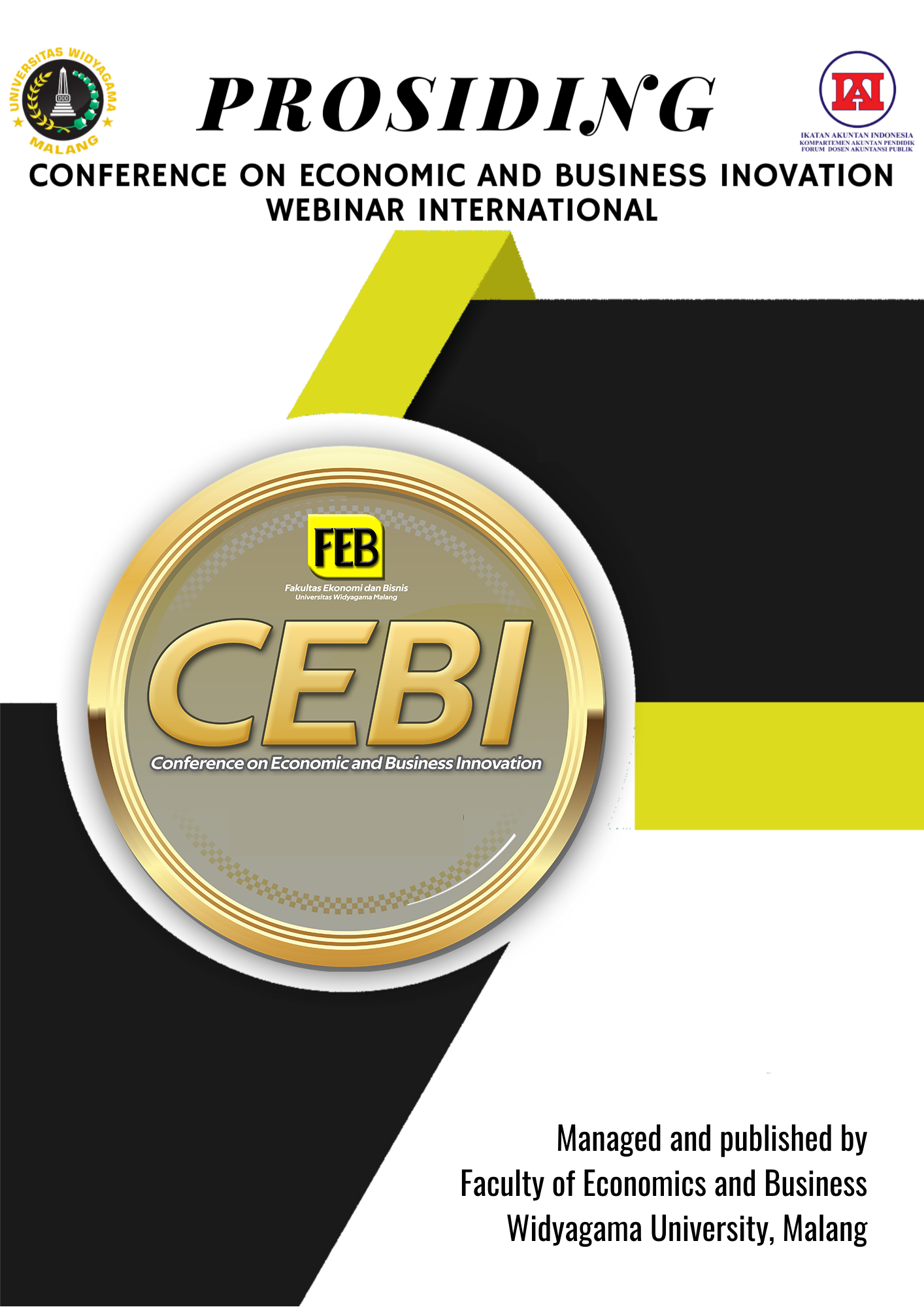Determinan Utang Perusahaan Industri Manufaktur di Indonesia yang Terdaftar di Bursa Efek Indonesia Periode 2011-2020
Keywords:
Debt Determinants, Long-term Debt (LDT), Investment, Cash Flow Operation (CFO), Exchange RateAbstract
This study aims to determine the Debt Determinants of Manufacturing Industry Companies in Indonesia which are listed on the Indonesia Stock Exchange for the period 2011 – 2020. The data used in this study is secondary data. The data is quantitative data obtained from the Indonesia Stock Exchange (IDX) with stocks classified as the Kompas100 Index in the form of annual financial reports for the period 2011 – 2020. The research sample was 20 companies obtained by purposive sampling technique. The data analysis technique used is multiple linear regression analysis and hypothesis testing using partial t-test, simultaneous F-test and coefficient of determination test. The data analysis technique was carried out using the Eviews10 for Windows program. The results show that Long-term Debt (LDT) and Investment partially have a positive and significant effect on debt. Cash Flow Operation (CFO) partially has a negative and significant effect on debt. Exchange rates partially have no effect on debt. Long-term Debt (LDT), Investment, Cash Flow Operation (CFO) and the Exchange Rate simultaneously affect debt.
References
Adedeji, A. (1998). Does the Pecking Order Hypothesis Explain the Dividen Payout Ratios of Firms in the UK; Journal of Business Finance & Accounting 25; 1127–1155.
Amirya, M., & Atmini, S. (2008). Serta Hubungan Tingkat Hutang Terhadap Nilai Perusahaan : Perspektif Pecking Order Theory; Jurnal Akuntansi dan Keuangan Indonesia, Vol. 5, No. 2; pp.227-244.
Baker, M. J. W. (2002). Market Timig Capital Stucture; Journal of Finance. 57, 1–32.
Brealey, Richard A dan Myers, S. C. (2000). Principles of Corporate Finance. New York: mc Graw Hill.
Donaldson, G. (1961). Corporate Debt Capacity: A Study of Corporate Debt policy and the Determination of Corporate Debt Capacity; Boston: Division of Research, Harvard school of Business Administration.
Dwi, P. (2011). Analisis Laporan Keuangan Konsep dan Aplikasi. Edisi ketiga, Yogyakarta; Sekolah Tinggi Ilmu Manajemen YKPN.
Firmansyah, Rinaldi & Sudarma, M & P, Y. (2016). Rinaldi Yonnia Firmansyah, Made Sudarma, Yeney Widia P Department of Accounting, Faculty of Economics And Business, Brawijaya University, Indonesia. XIII(1).
Fuad, M & Wandari, A. (2018). Pengaruh Struktur Modal dan Faktor Eksternal terhadap Nilai Perusahaan (Studi pada PT. Bank Central Asia, Tbk) 1). 7(1), 32–46.
Ginting, M. (2016). Pengaruh tingkat suku bunga, nilai tukar dan inflasi terhadap harga saham.
Hady, H. (2016). Manajemen Keuangan Internasional; Edisi 4 Jakarta; Mitra Wacana Media.
Hardiningsih, Pancawati & Oktaviani, M, R. (2012). Determinan kebijakan hutang (dalam Agency Theory dan Pecking Order Theory; Dinamika Akuntansi, Keuangan dan Perbankan. 1(1), 11–24.
Kaaro, H. (2001). Analisis Tingkat Hutang dan Dividen dalam Lingkungan Ketidakpastian: Pendekatan Pecking Order Theory dan Balancing Theory. 1067–1083.
Levi, M. D. (2009). Internasional Finance, Fifth Edition; New York; Routledge.
Linda, L., Lautania, M. F., & Arfandynata, M. (2017). Determinan Kebijakan Hutang (Bukti Empiris Pada Perusahaan yang Terdaftar Di Bursa Efek Indonesia). Jurnal Dinamika Akuntansi Dan Bisnis, 4(1), 91–112.
Manurung, A. (2004). Teori Struktur Modal: Sebuah Survei; Majalah Usahawan, No. 04, Tn. 33; 20–26.
Manurung, Adler H. (2019); Model dan Estimasi dalam Riset Manajemen dan Keuangan; Jakarta; PT. Adler Manurung Press.
Manurung, A. H. (2021a). Keuangan Perusahaan; Jakarta; PT. Adler Manurung Press.
Manurung, A. H., Tjahjana, D., Pangaribuan. C. H. dan M. E. Tambunan (2021b). Metode Riset Akuntansi, Investasi Keuangan dan Manajemen; Jakarta; PT. Adler Manurung Press.
Manurung, A. H. (2022), Regression and Extension, PT Adler Manurung Press
Miller, m. and F. M. (1961). Dividend Policy, growth and the valuation of shares. 34, 411–433.
Moddigliani, F. & M. M. (1958). The Cost of Capital, Corporation Finance of Theory of Investment; American Economic Review, 48, 261–297.
Myers, S. C. (1984). The Capital Structure puzzle. Journal of Finance. 39, 575–592.
Nopirin. (2012). Pengantar Ilmu Ekonomi Mikro – Makro; Yogyakarta; BPFE Yogyakarta.
Nym, N., & Yuliantari, A. (2014). Pengaruh Financial Ratio , Firm Size , Dan Cash Flow Operating Terhadap Return Share Perusahaan F & B. 3, 547–558.
Richard G. Lipsey, D. (1991). Pengantar Makroekonomi; Jakarta, Erlangga.
Rubeinstein, M. E. (1973). A Mean - Variance Synthesis of Corporate Finance Theory. Journal of Finance, 28, 167–181.
Siregar, B. (2005). Hubungan Antara Deviden, Leverage Keuangan, dan Investasi; Jurnal Akuntansi dan Manajemen, 16, 219–230.
Stiglitz, J. E. (1969). A Re-Examination of the Modigliani-Miller Theorem; American Economic Review, 59, 784–793.
Sudarma, M. (2004). Pengaruh Struktur Kepemilikan Saham, Faktor Internal dan Eksternal Terhdap Struktur Modal dan Nilai Perusahaan.
Sukirno, S. (2004). Makroekonomi Teori Pengantar ; Jakarta; PT. Raja Grafindo Persada.
Sukirno, S. (2011). Pengantar Ekonomi Makro, Edisi III ; Jakarta; PT. Raja Grafindo Persada.
Sujarweni, V . W. (2019); Metodologi penelitian bisnis dan ekonomi pendekatan kuantitatif; Yogyakarta Pustaka Baru.Suwaldimana, dalam M. 2015. (2018).
Pengaruh Free Cash Flow, Operating Cash Flwo, dan Dividen Payout Ratio Terhadap Nilai Perusahaan. 10(1), 52–65.










